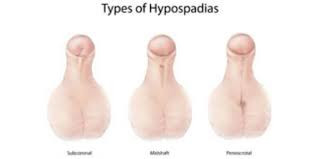Definisi
Hipospadia adalah kelainan bawaan pada laki-laki dimana lubang uretra (saluran yang mengalirkan urine dari kandung kemih keluar dari tubuh) dan penis mengalami gangguan perkembangan. Pada kondisi ini, lubang uretra tidak berada pada di ujung penis, melainkan di permukaan bawah dari penis.
Kondisi ini merupakan kelainan yang cukup sering ditemui. Para ahli memperkirakan bahwa 1 dari 200 bayi lahir dengan hipospadia di Amerika Serikat. Hipospadia menjadi satu kelainan bawaan yang paling banyak terjadi, namun hipospadia tidak menyebabkan kesulitan dalam merawat bayi. Operasi biasanya akan mengembalikan bentuk normal dari penis bayi. Dengan terapi hipospadia yang sukses, kebanyakan laki-laki dapat berkemih dan bereproduksi dengan normal.
Penyebab
Penis mulai mengalami perkembangan sejak saat janin. Struktur genitalia (alat kelamin) luar berbentuk sama pada laki-laki dan perempuan sampai usia kehamilan 8 minggu, dimana setelahnya struktur genitalia akan berkembang menjadi bentuk maskulin pada laki-laki, akibat pengaruh hormon testosteron dan dihidrotestosteron. Hormon ini akan menstimulasi pembentukan uretra dan kulup penis (preputium). Pada laki-laki dengan hipospadia, uretra terbentuk secara abnormal saat minggu ke 8 sampai 14 kehamilan akibat gangguan pada kerja hormon ini.
Namun, pada kebanyakan kasus penyebab hipospadia tidak diketahui. Terkadang, hipospadia timbul sebagai akibat dari kombinasi faktor genetik dan faktor lingkungan. Beberapa faktor yang dapat memengaruhi adalah paparan ibu hamil terhadap zat di lingkungannya, apa yang ibu makan dan minum, atau obat-obatan tertentu yang digunakan saat kehamilan.
Faktor Risiko
Meskipun penyebab hipospadia biasanya tidak diketahui, namun beberapa faktor dibawah ini dapat meningkatkan risiko melahirkan bayi laki-laki dengan hipospadia:
- Usia dan berat badan ibu. Ibu hamil yang berusia 35 tahun atau lebih dan termasuk obesitas memiliki risiko lebih tinggi melahirkan bayi dengan hipospadia
- Terapi kesuburan. Ibu yang menggunakan teknologi bantuan reproduksi untuk membantu kehamilan. Memiliki risiko lebih tinggi melahirkan bayi dengan hipospadia
- Hormon tertentu. Ibu yang mengonsumsi hormon tertentu sesaat sebelum atau selama kehamilan terbukti memiliki risiko lebih tinggi melahirkan bayi dengan hipospadia
- Riwayat keluarga dengan hipospadia. Hipospadia lebih sering ditemukan pada bayi dengan riwayat keluarga dengan hipospadia
- Paparan zat tertentu saat kehamilan. Terdapat spekulasi mengenai hubungan antara hipospadia dan paparan ibu terhadap zat tertentu seperti pesitida ataupun zat kimia industri, tetapi masih perlu penelitian lebih lanjut untuk membuktikan hal tersebut
Gejala
Pada hipospadia, lubang uretra berlokasi pada sisi bawah dari penis, bukan di ujung penis. Lubang abnormal dapat terbentuk dimana saja dari bagian bawah ujung penis sampai skrotum (kantung buah zakar). Klasifikasi hipospadia berdasarkan lokasi lubang uretra adalah:
- Depan (anterior), terdiri dari hipospadia glanular dan subkoronal. Pada tipe ini, lubang uretra berlokasi di dekat kepala penis
- Tengah (Midschaft), lubang uretra berlokasi di sepanjang batang penis
- Belakang (posterior), lubang uretra berada pada pertemuan penis dan skrotum, skrotum, ataupun perineum
Lokasi hipospadia berada di depan pada 50% kasus, tengah pada 20% kasus, dan posterior pada 30% kasus. Lokasi subkoronal adalah yang paling sering ditemukan diantara semua lokasi.
Pada bentuk yang berat, lubang uretra dapat berada di antara skrotum dan anus (perineum).
Laki-laki dengan hipospadia terkadang dapat memiliki gejala seperti:
- Uretra berada di lokasi selain ujung penis
- Penis yang bengkok ke bawah (chordee). Chordee sering berkaitan dengan hipospadia, terutama pada kasus yang berat. Pembengkokan dapat ringan sampai sangat berat (membentuk sudut 90 derajat)
- Gangguan pancaran urine dan mungkin harus duduk untuk berkemih
- Penis tampak seperti berkerudung (hooded foreskin) karena hanya setengah atas penis yang tertutup oleh kulup penis atau preputium
- Pada beberapa laki-laki dengan hipospadia, testis (buah zakar) belum turun sempurna ke skrotum
Diagnosa
Hipospadia biasanya terdiagnosis saat pemeriksaan fisik setelah bayi baru lahir. Pemeriksaan hipospadia menjadi pemeriksaan yang rutin yang dilakukan setelah bayi lahir. Pada saat pemeriksaan, dokter dapat menemukan lubang uretra yang tidak berada pada ujung penis. Seringkali, kulup penis tidak terbentuk, sehingga ujung penis dapat terbuka.
Tidak ada tes laboratorium yang dapat membantu dalam menegakkan diagnosis hipospadia. Pada kasus yang dicurigai terjadi gangguan pada perkembangan alat kelamin, pemeriksaan hormon mungkin diperlukan.
Jika ditemukan adanya hipospadia, dokter akan merujuk anak Anda ke dokter bedah yang memiliki spesialisasi di bidang genital atau sistem kemih (urologi pediatri) untuk evaluasi lebih lanjut.
Tata Laksana
Terapi hipospadia bergantung pada tipe kelainan yang dimiliki bayi. Beberapa bentuk hipospadia sangat ringan dan tidak membutuhkan operasi. Namun, kebanyakan kasus hipospadia akan membutuhkan operasi untuk memperbaiki lokasi lubang uretra dan meluruskan batang penis yang bengkok. Jika operasi diperlukan, biasanya dilakukan ketika bayi berusia 3 sampai 18 bulan.
Kebanyakan bentuk hipospadia dapat diterapi dengan satu kali operasi yang dilakukan dengan rawat jalan atau one day care. Pada beberapa kasus, operasi dilakukan beberapa kali untuk memperbaiki kelainan. Beberapa perbaikan yang dilakukan saat operasi meliputi:
- Menempatkan lubang uretra pada tempat yang seharusnya. Ketika lubang uretra berada di dekat pangkal penis, dokter mungkin akan memerlukan cangkok jaringan yang diambil dari kulup penis atau dari bagian dalam mulut untuk merekonstruksi saluran kemih menjadi posisi yang tepat dan memperbaiki hipospadia. Oleh karena itu, seorang bayi laki-laki dengan hipospadia tidak boleh disirkumsisi atau dikhitan, karena dokter mungkin akan menggunakan kulup penis untuk memperbaiki hipospadia
- Memperbaiki penis yang bengkok
- Memperbaiki kulit di sekitar lubang uretra
Pada kebanyakan kasus, tingkat keberhasilan operasi tinggi. Penis juga biasanya akan terlihat normal setelah operasi. Anak dapat berkemih dan bereproduksi dengan normal.
Setelah operasi, anak akan membutuhkan beberapa kali kunjungan ke dokter bedah. Setelah itu, kunjungan ke dokter urologi anak secara teratur direkomendasikan setelah toilet training dan saat pubertas untuk mengecek penyembuhan dan komplikasi yang mungkin terjadi.
Komplikasi
Jika tidak ditangani, hipospadia dapat menyebabkan masalah di kemudian hari, seperti:
- Kesulitan dalam berhubungan seksual. Pada pria dengan hipospadia, bentuk penis saat ereksi dapat tidak normal, serta dapat memiliki masalah terkait ejakulasi
- Kesulitan berkemih ketika berdiri
- Bentuk penis abnormal
Selain itu, terdapat komplikasi dari terapi. Terkadang, akan terbentuk lubang di bagian bawah penis tempat saluran kemih yang baru dibuat sehingga dapat terjadi kebocoran urine. Meskipun jarang, dapat terjadi masalah dalam penyembuhan luka operasi atau terbentuknya jaringan luka. Komplikasi ini membutuhkan tindakan operasi untuk perbaikan.
Pencegahan
Ibu hamil dapat mengurangi risiko bayinya terkena hipopspadia dengan menerapkan gaya hidup sehat seperti:
- Tidak merokok atau minum alkohol
- Mempertahankan berat badan ideal
- Mengonsumsi asam folat (sekitar 400 sampai 800 mikrogram per hari) ketika hamil
- Melakukan pemeriksaan kehamilan rutin
Kapan Harus ke Dokter ?
Kebanyakan bayi dengan hipospadia terdiagnosa sesaat setelah lahir ketika masih di rumah sakit atau fasilitas kesehatan. Namun, perubahan posisi lubang uretra yang hanya sedikit saja mungkin lebih sulit untuk diidentifikasi dan mungkin terlewat. Anda sebaiknya berkonsultasi dengan dokter jika Anda memiliki kekhawatiran mengenai bentuk penis anak Anda atau jika ada masalah dalam berkemih.
Selain itu, jika Anda sedang hamil atau merencanakan kehamilan, berkonsultasilah dengan dokter untuk meningkatkan kemungkinan melahirkan bayi yang sehat.
Mau tahu informasi seputar penyakit lainnya? Cek di sini, ya!
- dr Nadia Opmalina
CDC. Facts About Hypospadias. (2022). Retrieved 5 July 2022, from https://www.cdc.gov/ncbddd/birthdefects/hypospadias.html
Hypospadias - Symptoms and causes. (2022). Retrieved 5 July 2022, from https://www.mayoclinic.org/diseases-conditions/hypospadias/symptoms-causes/syc-20355148
Hypospadias: Practice Essentials, Pathophysiology, Etiology. (2022). Retrieved 5 July 2022, from https://emedicine.medscape.com/article/1015227-overview#a5
Hypospadias: Causes, Diagnosis & Treatment. (2022). Retrieved 5 July 2022, from https://my.clevelandclinic.org/health/diseases/15060-hypospadias#prevention












